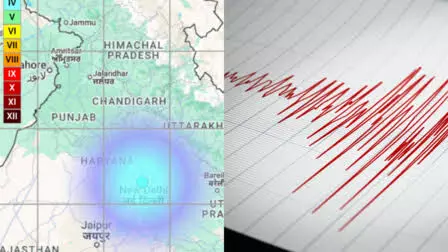Explained: Why did Delhi earthquake make a loud rumbling sound?
Earthquakes have waves. These waves have names. The first wave is called the primary wave
By Anoushka Caroline Williams
Explained: Why did Delhi earthquake make a loud rumbling sound?
Hyderabad: A strong earthquake of magnitude 4.0 struck Delhi early Monday at 5:36 am, with its epicentre in Dhaula Kuan at a depth of 5 km. While tremors were widely felt across the city and surrounding areas, several people also reported hearing a loud rumbling sound during the quake.
Why did people hear a loud sound?
Speaking to NewsMeter, Dr Sri Nagesh, a retired scientist at CSIR-NGRI, stated that the loud booming sound was not unusual, and it indicated the earthquake’s shallow depth.
“It is not something extraordinary. It just shows that the earthquake was a shallow one. Suppose a train is coming, as it gets closer, the sound gets louder. In the same way, when an earthquake occurs, seismic waves travel through the ground, producing vibrations that can be heard.”
“Earthquakes have waves. These waves have names. The first wave is called the primary wave,” Dr Sri Nagesh said.
The #Earthquake occuree at 5:37am in #Delhi & North India was massive and chances of aftershocks are there and it also came with a sound which can be heard in this video!!!PRELIMINARY AWAITED!!! https://t.co/smLE794Yae pic.twitter.com/YLkaBkIhhd
— IndiaMetSky Weather (@indiametsky) February 17, 2025
How do earthquakes produce sound?
Dr Nagesh explained the reason for the sound: “The rumbling noise associated with earthquakes occurs due to the interaction of seismic waves with the Earth’s surface and surrounding structures.”
Key factors that can produce the sound are:
1. Low-Frequency Vibrations: Earthquakes generate seismic waves, particularly P-waves (primary waves) and surface waves, which create low-frequency vibrations. These can sometimes be perceived as a deep rumbling sound.
2. Ground Movement and Friction: As rocks and soil shift along the fault line, they grind against each other, producing vibrations that travel as sound waves through the air. This process is like the noise produced by landslides or rockfalls.
3. Resonance in Buildings and the Atmosphere: The shaking caused by seismic waves can make buildings, bridges and other structures vibrate, amplifying or modifying the sound in certain areas. The Earth’s surface itself can also act as a resonator, making the noise more noticeable.
4. Depth and Intensity of the Earthquake: Shallow earthquakes (those closer to the surface) tend to produce louder sounds because seismic energy reaches the surface more directly. Deeper earthquakes, in contrast, may not generate as much audible noise.
5. Airborne Transmission: Sometimes, an earthquake releases energy that travels through the air as sound waves, creating a booming or roaring noise before the ground starts shaking.
Was this unusual for Delhi?
“Seismic activity is not uncommon in Delhi-NCR, which lies in Seismic Zone IV, making it vulnerable to moderate to strong earthquakes. However, not all earthquakes are accompanied by a loud sound. The depth, intensity, and geological conditions determine whether a quake will produce an audible rumbling noise” Dr Nagesh concluded.
As experts continue to analyse the event, authorities have reassured the public that no major damage was reported. The National Disaster Response Force (NDRF) has advised residents to stay cautious and follow earthquake safety protocols.